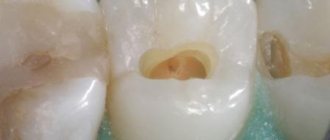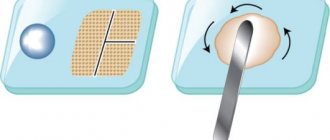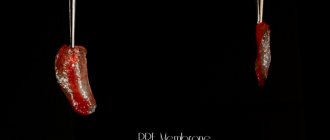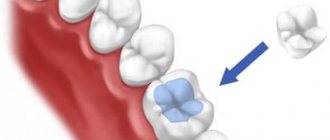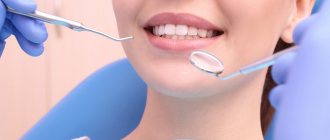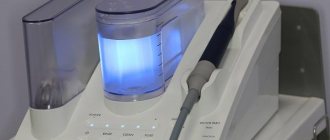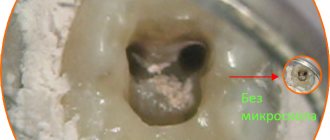Features of the composition
Since this material is a compomer, it contains both elements of a composite and glass ionomer cement.
What it has in common with the first is the presence of a matrix of oligocarboxylic and polycarboxylic acids in combination with resins. This is what is responsible for the ability to photopolymerize. Glass ionomer consists of fluorine and zinc ions. The amount of such filler by volume is 55%.
The release form is a syringe with a mass of 0.33 g. You can purchase a package containing 30 pieces.
Ionosit Baseliner (Ionosit) (0.33 g) - light-curing glass ionomer cushioning material
Dear customers. Delivery in three conditional zones - “Krasnodar, Krasnodar Territory and the Russian Federation”.
Delivery in Krasnodar
When ordering from 5,000 rub.
— delivery within Krasnodar is free. The goods are delivered from 09:00 to 18:00 within 1-2 working days only to medical workers at their workplace.
Payment in cash is made at the time of delivery of the order. You transfer the money to the courier and receive the ordered goods with all the necessary documents.
Please note that in the event of a failed delivery due to the fault of the Client (it is impossible to reach the Client on the day of delivery, the Client is not at the specified address, etc.), re-delivery is carried out after agreement with the manager.
Krasnodar region
The goods are delivered once every two weeks from 09:00 to 18:00
when ordering goods in the amount of 10,000 rubles. — delivery is free
Russia
The goods are delivered by “Business Lines” transport according to their terms and tariffs to the terminal or door (at the Client’s choice). Usually it takes 2-3 days.
Delivery to shopping center is carried out the next working day after payment of the order.
The transport company's services are paid by the recipient.
We do not accept cash on delivery!
Cashless payment
You place an order, we issue you an invoice valid for payment within 3 days. After the money has been received into our account, the courier will deliver your paid order within 1-2 business days. Also within 1-2 days we will send the goods by transport company.
Receipt of goods
The goods can be received by the person who made the order, or by another person located at the address specified in the order and ready to pay and accept the goods.
Upon receipt of the goods, it is necessary to check the condition of the packaging in the presence of a delivery service employee. If the packaging is not damaged, open it and carefully examine the appearance and completeness of the product. The seller demonstrates and transfers the goods to the buyer in the manufacturer's original packaging, in the assortment and quantity specified in the order.
According to Decree of the Government of the Russian Federation dated January 19, 1998 No. 55, the following goods of proper quality are not subject to exchange or return:
- medications
- personal hygiene items, oral hygiene products
- medical instruments, devices and equipment
- sanitary and hygiene items made of metal, rubber, textiles and other materials
- baby care items
- spectacle lenses
- perfumery and cosmetic products.
Material properties
Most dental materials can irritate the dental pulp. For example, in the case of composites, its organic matrix has this property. Insulating pads help to avoid such negative effects.
At the same time, the filling material is protected from the effects of dental lymph. As a result, the adhesion of the filling improves and the risk of violation of its boundaries and the formation of microcracks due to polymerization shrinkage of the composite is reduced.
Ionositol also has the following properties:
- complete absence of toxicity;
- high tensile strength;
- satisfactory compression resistance;
- insolubility under the influence of acids and monomers released by filling materials;
- low level of heat conductivity;
- adhesion to tooth tissues;
- radiopacity;
- thermal resolution coefficient almost equal to that of the tooth;
- due to the influence of fluoride and zinc ions, it has a preventive effect and prevents the re-formation of caries;
- reduces the likelihood of post-filling pain due to hermetically sealed dentin tubules.
Features of application
Method of applying the lining:
- Cleaning the tooth.
- Treatment of a carious cavity in accordance with all the rules of preparation for filling with light-curing materials.
- Applying insulation. Preference is given to rubber dam.
- Etching the carious cavity with orthophosphoric acid according to the chosen method. The best method is total etching.
- If necessary, apply an adhesion promoter. This depends on the instructions of the filling material manufacturer.
- Ionosit can be applied in 2 options. In the first case, they cover only the bottom of the carious cavity, and the material acts as a regular insulating lining. In the second option, it is applied to all walls. This relieves the tension of the filling material that will be applied later. The layer thickness should be no more than 1 mm.
- Polymerizes for 20 seconds.
- Placing a permanent filling.
Recommended method of use Ionositol
- Clean the tooth before preparing, using a stream of water to remove any remaining cleaning agents. The use of cofferdam is not required if moisture formation can be controlled in another way. During use, avoid contamination with saliva.
- Prepare the tooth cavity in accordance with the general rules of adhesive technique. Trim the edges of the tooth enamel. If cavities are deep, protect the pulp using suitable products.
- Etch the cavity using your preferred method, such as Total-Etch. Follow the manufacturer's instructions for the material used.
- Apply adhesion promoter following manufacturer's directions.
- Ionositol can be used as a general lining material (coating the base of a cavity), as well as to cover the entire cavity (for stress relief). Apply lonosit-Baseliner with a brush or any spherical tool in a layer approximately 1 mm thick.
- Shine a suitable dental light for at least 20 seconds.
- Apply composite filling material according to the manufacturer's instructions.
Method and storage period Store in a dry place at room temperature (15 to 25 °C / 59 to 77 °F). Do not use after expiration date.
special instructions
Ionositol has some features that are important to observe when using:
- The wavelength of photopolymerization lamps should be 450 nm. The lamp itself should be in such a position that the distance to the material is minimal.
- When working with metal tools, you need to remember to clean them immediately after adding the material, as it can stick to them.
- Immediately after use, the syringe is tightly closed with a cap. Like any other light-curing material, the material can harden under the influence of ambient light.
- The inhibited layer is not removed, as it is necessary to connect the lining with the next layers of the filling.
- When restoring contact points, it is recommended to use matrix systems.
Currently, no systemic effects on the body have been identified. Only in isolated cases is it possible to develop both general allergic reactions and local changes when exposed to components.
Ionosit Baseliner (20 spr x 0.33 g)
IONOSIT BASELINER (IONOSIT) is a light-curing, radiopaque compomer cushioning material. The controlled expansion of the lonosit-Baseliner material compensates for the shrinkage of the composite filling.
Ionosit Baseliner is the latest highly effective material, which is a glass ionomer and is used as spacers for fillings - under amalgam, composite and ceramic restorations. Less commonly, Ionosit Baseliner is used to seal undercuts. The main advantage of the compomer is the protection of the tooth from the formation of cracks and polymerization shrinkage due to composite restorations. Ionosit Baseliner has controlled expansion, which is extremely convenient to use. In addition, the use of this material reduces the likelihood of postoperative sensitivity and the formation of new caries to a minimum. Due to the content of zinc in the composition and the release of fluorides, it provides an antiseptic effect and reliably protects the pulp and dentinal tubules. It is transparent to X-ray transmission. The cement is cured by exposure to light and is one-component, which means it eliminates manual mixing. Saferin syringes are used for ease of application.
Composition: glass ionomer in a matrix of polymerizable oligo- and polycarboxylic acid and other light-curing dental resins.
The glass ionomer used contains fluoride and zinc ions. Filler content: 72 wt. % = 49 vol.% (0.02-33 µm).
Lining material for composite restoration. Filling undercuts
Basic Precautions
- Intended exclusively for use in dentistry!
- Keep out of the reach of children!
Side effects
- To date, no systemic side effects have been detected. In isolated cases, hypersensitivity or contact allergy to the components of the material cannot be ruled out.
INSTRUCTIONS FOR USE OF IONOSIT
- The emission of light devices should be 450 nm. They need to be checked regularly. The light intensity must be at least 400 mW/cm2. Place the light source as close to the material as possible.
- Ionosite sticks to metal tools. Therefore, clean the tools with a paper towel before the material hardens.
- Ionositol is a photosensitive material. Avoid premature activation of the material by ambient light and close the lid immediately after use.
- Do not remove the oxygen inhibited layer as it is required to bond to the next layer of material.
- The use of a matrix is recommended. Follow the instructions for use of other materials used.
RECOMMENDED USE OF IONOSITE
- Clean the tooth before preparing, using a stream of water to remove any remaining cleaning agents. The use of cofferdam is not required if moisture formation can be controlled in another way. During use, avoid contamination with saliva.
- Prepare the tooth cavity in accordance with the general rules of adhesive technique. Trim the edges of the tooth enamel. If cavities are deep, protect the pulp using suitable products.
- Etch the cavity using your preferred method, such as Total-Etch. Follow the manufacturer's instructions for the material used.
- Apply adhesion promoter following manufacturer's directions.
- Ionositol can be used as a general lining material (coating the base of a cavity), as well as to cover the entire cavity (for stress relief). Apply lonosit-Baseliner with a brush or any spherical tool in a layer approximately 1 mm thick.
- Shine a suitable dental light for at least 20 seconds.
- Apply composite filling material according to the manufacturer's instructions.
Method and storage period Store in a dry place at room temperature (15 to 25 °C / 59 to 77 °F). Do not use after expiration date.
Similar drugs
The following analogues of Ionosit exist on the dental materials market:
- Fuji Line , manufacturer GC. It belongs to light-curing glass ionomers. Its advantage is small shrinkage after polymerization.
- Fuji 9 , also manufactured by GC. This cement is a conventional chemically cured glass ionomer.
- Ionosil , manufacturer - VOCO company. Also glass ionomer cement, which is cured by light polymerization. It is almost a complete analogue.
- Base It , manufacturer of Spident. It differs in that it contains calcium hydroxide. Therefore, this material can be used not only as an insulating lining, but also as a therapeutic one.
- TimeLine , made by Dentsply. This material has the ability to bond to dentin without further processing and to composite without acid etching.
- Vitrebond , manufactured by 3M ESPE. Refers to light-curing glass ionomers.
